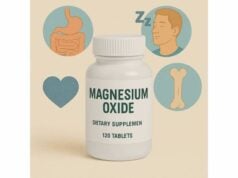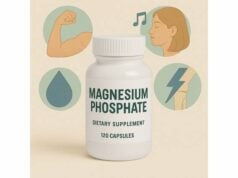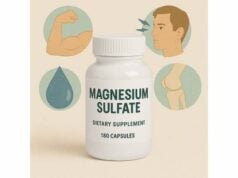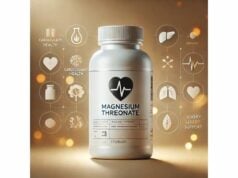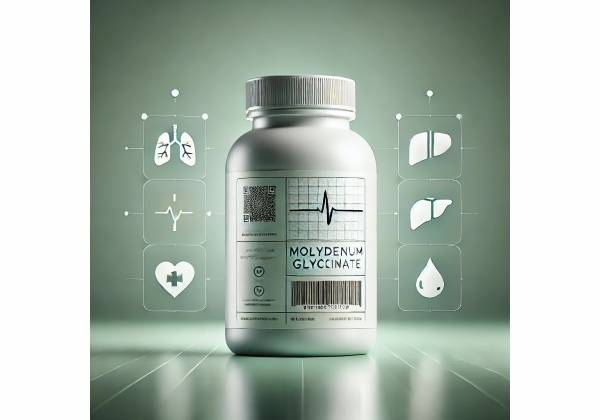
Molybdenum glycinate is a chelated form of the essential trace mineral molybdenum, designed to deliver small, precise amounts of elemental molybdenum with good solubility and gastrointestinal comfort. Your body needs only micrograms daily to build the molybdenum cofactor that powers four enzymes: sulfite oxidase (handles dietary sulfites), xanthine oxidase and aldehyde oxidase (process purines and many compounds), and mARC (helps reduce certain nitrogen-containing molecules). Because usual diets already supply enough, most people never need a standalone molybdenum supplement. Interest rises in narrower situations: people experimenting with support for sulfite sensitivity, those on restrictive diets, and individuals with medically managed nutrition. This guide explains what molybdenum glycinate is, how it works, who may benefit, how to select an appropriate product, what amounts make sense, and how to avoid side effects. You will find practical ranges that align with global reference values, plus clear red flags that call for medical advice. The goal is to help you decide whether molybdenum glycinate has a place in your routine—or whether food-first strategies are all you need.
Key Insights
- Supports enzymes that clear sulfites and process purines; deficiency is uncommon with normal eating.
- Typical supplemental range is 25–150 mcg/day of elemental molybdenum, adjusted to need and total intake.
- Respect regional upper limits: about 600–2,000 mcg/day for adults from all sources, depending on authority.
- High intakes may raise uric acid or affect copper status; avoid unsupervised use in gout or kidney disease.
Table of Contents
- What is molybdenum glycinate?
- Does it work and who benefits?
- Benefits you can expect and limits
- How to choose and take it
- How much should I take?
- Side effects, interactions, and who should avoid
What is molybdenum glycinate?
Molybdenum glycinate is a dietary supplement in which elemental molybdenum is bound to the amino acid glycine. The chelate helps keep the mineral soluble and gentle on the stomach. After you swallow it, digestive processes release molybdenum as molybdate (MoO₄²⁻), the form your cells use to assemble the molybdenum cofactor. That single cofactor enables four human enzymes to function: sulfite oxidase, xanthine oxidase, aldehyde oxidase, and mARC. Without enough cofactor, these enzymes slow and metabolic byproducts can build up.
From a practical standpoint, the most important line on the label is the elemental molybdenum amount, shown in micrograms (mcg). The chelate (glycinate) is simply one delivery vehicle. Other common forms—such as sodium molybdate or molybdenum citrate—also yield molybdate in the gut. In everyday use, form differences matter far less than getting the dose right and staying within safe limits.
Food normally covers needs. Legumes (beans, lentils, peas), whole grains, nuts, and organ meats contribute most, though soil content and water sources can shift the numbers. Because your kidneys excrete excess molybdenum efficiently, healthy people rarely accumulate it from food. Supplements come into play when intake is predictably low, when parenteral (non-oral) nutrition is used, or when a clinician supervises a short trial around sulfite-heavy meals. Even then, doses should remain small.
Marketers sometimes claim that glycinate is “best absorbed.” In reality, mainstream forms are well absorbed, and head-to-head human trials have not shown clinically meaningful superiority among them in healthy people. Choose a form you tolerate, from a brand that discloses the elemental amount and tests for quality.
Finally, context matters. Molybdenum is essential, but more is not better. Your enzymes need micrograms, not milligrams. Staying within recommended intakes protects against unintended effects, such as shifts in uric acid or copper balance at higher exposures.
Does it work and who benefits?
Molybdenum glycinate “works” in the sense that it supplies elemental molybdenum that your body uses to build the cofactor for four enzymes. Whether you personally benefit depends on your baseline diet, health status, and goals.
Groups that may reasonably consider it (with clinician input):
- People who react to high-sulfite foods or drinks. Sulfite oxidase requires the molybdenum cofactor to convert sulfites (preservatives found in some wines, dried fruits, condiments, and processed foods) to sulfate for excretion. If your diet is high in sulfites and your intake of molybdenum is marginal, optimizing cofactor availability may help. Results vary because reactions can stem from many triggers besides sulfites, including histamine and alcohol.
- Those on very restricted diets or long-term medical nutrition. Highly selective eating patterns, elemental diets, or parenteral nutrition call for deliberate trace element planning. In these settings, supplementation is medical, not DIY.
- Individuals exploring enzyme support during an elimination or reintroduction plan. A brief, low-dose trial timed with meals is sometimes used to standardize conditions while you test foods systematically.
Who likely does not benefit:
- Healthy adults eating varied diets. Most people in developed countries meet or exceed daily needs through food. Additional molybdenum rarely produces noticeable effects in this group.
- Anyone seeking vague “detox” effects. The cofactor pathways operate as needed when requirements are met. Extra molybdenum will not “supercharge” detoxification.
What a realistic response looks like:
- If sulfites are a true trigger and your diet has been borderline in molybdenum, bringing intake to an appropriate level may reduce intensity or frequency of symptoms during exposure. Improvements, if any, tend to be subtle and context-dependent. A simple symptom diary—date, food, amount, timing, and response—helps you decide whether the supplement matters or if dietary changes are sufficient.
Where supplementation is not appropriate:
- Inherited disorders of the molybdenum cofactor or sulfite oxidase. These rare conditions are serious and managed with specialist therapies. Over-the-counter molybdenum salts are not a treatment.
- Gout or hyperuricemia without oversight. Because xanthine oxidase produces uric acid, higher molybdenum intakes can be counterproductive.
The bottom line: molybdenum glycinate is a precise tool for narrow use cases. For most people, optimizing food patterns and avoiding unnecessary sulfite exposure will matter far more than adding a separate molybdenum capsule.
Benefits you can expect and limits
Enzyme support, not a stimulant. The main “benefit” of molybdenum is invisible: enzyme pathways run as designed. When intake is adequate, your body converts molybdenum into the cofactor and supplies it to:
- Sulfite oxidase: converts sulfite to sulfate so you can excrete it safely.
- Xanthine oxidase: converts xanthine and hypoxanthine to uric acid in purine metabolism.
- Aldehyde oxidase: helps process diverse compounds, including some medications.
- mARC enzymes: reduce specific nitrogen-containing molecules in partnership with other proteins.
Potential advantages of getting enough (not too much):
- Smoother sulfite handling if your prior intake was borderline and you frequently eat or drink higher-sulfite items.
- Predictable drug metabolism where aldehyde oxidase participates—adequacy reduces one source of variability, though it does not guarantee a specific drug response.
- Nutritional insurance during periods of restricted eating, when legumes and whole grains (key food sources) are limited.
Clear limits to understand:
- Deficiency is rare in free-living adults. Outside of medical nutrition scenarios or extreme dietary restriction, most people meet needs through food alone. No energy boost, weight loss, or performance benefit should be expected from extra molybdenum.
- Sulfite reactions have multiple triggers. If a cautious trial does not change your response to wine, dried fruit, or condiments known to contain sulfites, discontinue and reassess; histamine, alcohol, or other factors may be the real cause.
- “Chelate magic” is marketing. Glycinate is a legitimate form, but mainstream molybdenum salts are also well absorbed. The clinically significant variable is the elemental dose, not a promise that one form is uniquely powerful.
- More is not better. Excess molybdenum can nudge uric acid upward or interfere with copper status over time. Extremely high intakes have been linked, rarely, to neurologic symptoms. These risks are avoidable by staying within established limits.
Where molybdenum shines—in real life:
- Structured food trials: When you are reintroducing sulfite-containing foods after an elimination phase, ensuring trace element adequacy avoids the confounder of marginal intake.
- Bridging restricted diets: A micro-dose supplement (e.g., 25–75 mcg/day) can serve as short-term insurance while you rebuild a varied plate rich in legumes and grains.
- Parenteral nutrition: Here, molybdenum is included deliberately under medical supervision.
Net takeaway: expect quiet, background support of enzyme systems—nothing more, nothing less. If benefits do not show up in your symptom journal within a defined time, keep your plan simple and stop the supplement.
How to choose and take it
1) Verify the elemental amount. Look for “Molybdenum (as molybdenum glycinate) — XX mcg.” This number, not the compound weight, determines your intake. Common serving sizes range from 25 to 500 mcg. For most people, products at the lower end are more appropriate.
2) Keep your purpose specific.
- Diet coverage while rebuilding variety: 25–75 mcg/day, short term.
- Cautious sulfite-focused trial: 25–150 mcg/day, often taken with meals that contain known sulfite sources.
- Medical nutrition (TPN): prescription-only; do not self-supplement.
3) Choose a simple formula. Single-ingredient capsules reduce confounding. If you use a multimineral, add up totals from all sources to avoid overshooting your daily limit.
4) Timing with meals. Absorption is good with or without food, but taking with meals usually improves comfort and aligns intake with sulfite exposure. If you are testing responses to specific foods, take your dose 15–30 minutes before the meal and record the outcome.
5) Quality signals. Prefer brands that:
- Disclose elemental molybdenum per serving and the specific form (“glycinate”).
- Provide lot-specific third-party testing for purity and identity.
- Avoid proprietary “detox blends” that add botanicals or high-dose minerals you do not need.
6) Track outcomes. If your goal is sulfite tolerance, log the food, portion, timing, dose, and symptoms for 2–4 weeks. If there is no clear improvement, stop the supplement and work on diet changes or alternative explanations for symptoms.
7) Pair with food-first habits. Long term, include legumes (chickpeas, black beans, lentils), whole grains (oats, barley, wheat berries), nuts, and seeds. These provide molybdenum plus fiber, protein, and other micronutrients.
8) Respect the ceiling. Upper limits for adults vary by region but generally fall between 600 mcg/day and 2,000 mcg/day from all sources. Your safest course is to stay well below the lower of the two limits that apply to you.
9) Know when to involve your clinician. If you have gout, kidney disease, copper-related issues, or unexplained anemia or neurologic symptoms, get personalized guidance before using any molybdenum supplement.
Used this way, molybdenum glycinate becomes a tidy, short-term tool—not a permanent fixture in your pillbox.
How much should I take?
Think in micrograms and start with why you are taking it. Then set a dose that meets the goal without approaching upper limits.
Daily requirement and typical intake
- General adult requirement: About 45 mcg/day is the widely cited daily reference value. Many adults surpass this through regular meals, especially if they eat legumes and whole grains.
- European guidance may cite an Adequate Intake near 65 mcg/day for older teens and adults when data are insufficient to set a classic requirement. Both figures underscore how small daily needs are.
Upper limits (from all sources, including food, fortified products, and supplements)
- A stricter reference used in parts of Europe is ~600 mcg/day for adults.
- A higher reference used in the United States is ~2,000 mcg/day for adults.
When in doubt, follow the lower limit recommended in your country or by your clinician.
Practical ranges for common goals
- Diet-coverage micro-dose: 25–75 mcg/day for several weeks while you diversify food intake.
- Sulfite-focused trial: 25–150 mcg/day, typically with meals or shortly before known sulfite exposures. If you see no meaningful change after 2–4 weeks, stop.
- Maintenance when a multivitamin already includes molybdenum: Additional standalone doses are usually unnecessary; total intake from all products should be reviewed.
Special situations
- Pregnancy and lactation: Standard prenatal supplements already account for trace minerals. Do not add a separate molybdenum product unless advised.
- Kidney disease: Because the kidneys clear molybdenum, even modest supplements may raise levels. Use only under medical supervision.
- Gout or high uric acid: Stay at the low end—or avoid supplementation—since higher intakes may elevate uric acid.
Reality check on “bigger” doses
Capsules supplying 250–500 mcg can push you toward regional upper limits when combined with a multivitamin or fortified foods. Unless you have a clinician-directed reason, stick to the lowest effective dose for the shortest sensible duration.
How to count your total
- Tally molybdenum from all supplements (multivitamins, multiminerals, “detox” formulas).
- Remember that food contributes too, especially if your diet features legumes and whole grains several times per week.
- Reassess monthly: if you do not have a well-defined benefit, discontinue.
Aim for sufficiency, not maximalism. Your enzymes need a tiny nudge, not a shove.
Side effects, interactions, and who should avoid
Typical tolerance at nutritional doses
Most people tolerate 25–150 mcg/day without trouble, especially when taken with food. Mild digestive upset is uncommon and usually resolves with dose adjustment.
Risks that rise with higher intakes or longer use
- Uric acid and gout: Because xanthine oxidase produces uric acid, higher molybdenum exposure can nudge levels upward. If you have gout, discuss any plan with your clinician and consider skipping molybdenum unless there is a compelling indication.
- Copper status: Chronically high molybdenum can antagonize copper metabolism, potentially contributing to anemia or neurologic complaints. This is unlikely at small doses but becomes plausible with sustained excess or multiple overlapping products.
- Neurologic symptoms at extreme intakes: Case reports link very high, long-term supplemental intakes to neuropsychiatric effects. Staying under recognized limits avoids this scenario.
- Kidney handling: Reduced renal function impairs molybdenum excretion. People with moderate-to-severe kidney disease should not self-supplement.
Medication and nutrient considerations
- Wilson’s disease therapy or copper chelators: Do not combine over-the-counter molybdenum with prescription copper-lowering therapy without specialist guidance.
- Drugs metabolized by aldehyde oxidase or mARC: Adequate molybdenum supports these enzyme families, but routine clinical interactions with small nutritional doses are not well defined. When starting or stopping any supplement, observe and report changes to your care team.
Who should avoid self-directed use
- Pregnant or breastfeeding individuals unless advised by a clinician.
- People with gout or persistently high uric acid.
- Those with clinically significant kidney disease.
- Anyone with unexplained anemia, neuropathy, or suspected copper deficiency until evaluated.
When to seek medical advice promptly
New or worsening joint pain, unusual fatigue, pallor, numbness, tingling, cognitive changes, severe headaches, or seizures after starting a high-dose product—stop the supplement and contact a clinician.
Smart safety habits
- Choose the lowest practical dose for the shortest necessary time.
- Keep total daily intake below your region’s upper limit.
- Revisit the reason you started every 4–8 weeks; if the benefit is unclear, discontinue.
- Prefer food-first strategies: a few servings of legumes and whole grains each week cover most people’s needs, at a fraction of the cost and with broader nutrition benefits.
Used thoughtfully, molybdenum glycinate can fill a narrow gap. Used casually at high doses, it can create new problems.
References
- Molybdenum – Health Professional Fact Sheet 2021 (Guideline)
- Overview on Tolerable Upper Intake Levels as derived by the Scientific Committee on Food (SCF) and the EFSA Panel on Dietetic Products, Nutrition and Allergies (NDA) 2025 (Guideline)
- Molybdenum – a scoping review for Nordic Nutrition Recommendations 2023 2023 (Systematic Review)
- Molybdenum Cofactor Deficiency in Humans 2022 (Review)
Disclaimer
This article is informational and not a substitute for personalized medical advice, diagnosis, or treatment. Always consult a qualified healthcare professional before starting, stopping, or changing any supplement, especially if you are pregnant or breastfeeding, have kidney disease, gout, copper-related disorders, or take prescription medications. If you choose to try molybdenum glycinate, use the lowest effective dose for the shortest time and keep total daily intake within the limits recommended in your country.
If this guide helped you, please consider sharing it on Facebook, X (formerly Twitter), or your preferred platform, and follow us for future evidence-based articles. Your support helps us keep producing reliable health content.

